Liwen Hu
SOAP: Style-Omniscient Animatable Portraits
May 08, 2025Abstract:Creating animatable 3D avatars from a single image remains challenging due to style limitations (realistic, cartoon, anime) and difficulties in handling accessories or hairstyles. While 3D diffusion models advance single-view reconstruction for general objects, outputs often lack animation controls or suffer from artifacts because of the domain gap. We propose SOAP, a style-omniscient framework to generate rigged, topology-consistent avatars from any portrait. Our method leverages a multiview diffusion model trained on 24K 3D heads with multiple styles and an adaptive optimization pipeline to deform the FLAME mesh while maintaining topology and rigging via differentiable rendering. The resulting textured avatars support FACS-based animation, integrate with eyeballs and teeth, and preserve details like braided hair or accessories. Extensive experiments demonstrate the superiority of our method over state-of-the-art techniques for both single-view head modeling and diffusion-based generation of Image-to-3D. Our code and data are publicly available for research purposes at https://github.com/TingtingLiao/soap.
Splats in Splats: Embedding Invisible 3D Watermark within Gaussian Splatting
Dec 04, 2024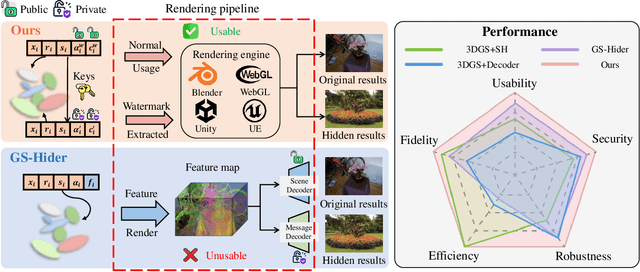

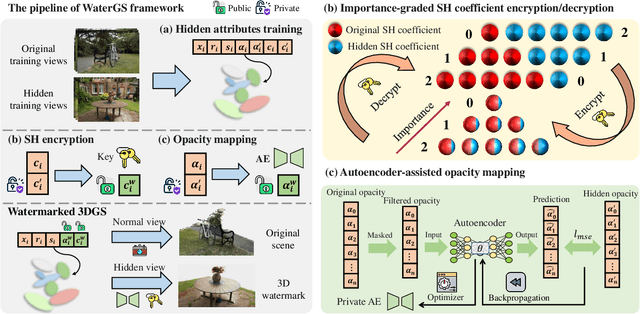
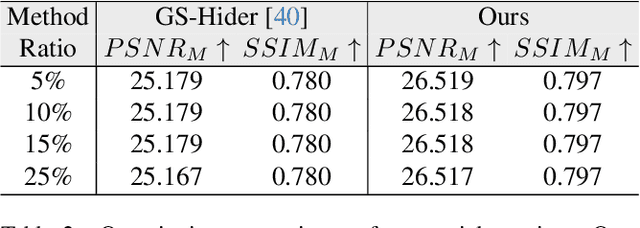
Abstract:3D Gaussian splatting (3DGS) has demonstrated impressive 3D reconstruction performance with explicit scene representations. Given the widespread application of 3DGS in 3D reconstruction and generation tasks, there is an urgent need to protect the copyright of 3DGS assets. However, existing copyright protection techniques for 3DGS overlook the usability of 3D assets, posing challenges for practical deployment. Here we describe WaterGS, the first 3DGS watermarking framework that embeds 3D content in 3DGS itself without modifying any attributes of the vanilla 3DGS. To achieve this, we take a deep insight into spherical harmonics (SH) and devise an importance-graded SH coefficient encryption strategy to embed the hidden SH coefficients. Furthermore, we employ a convolutional autoencoder to establish a mapping between the original Gaussian primitives' opacity and the hidden Gaussian primitives' opacity. Extensive experiments indicate that WaterGS significantly outperforms existing 3D steganography techniques, with 5.31% higher scene fidelity and 3X faster rendering speed, while ensuring security, robustness, and user experience. Codes and data will be released at https://water-gs.github.io.
PRTGS: Precomputed Radiance Transfer of Gaussian Splats for Real-Time High-Quality Relighting
Aug 07, 2024Abstract:We proposed Precomputed RadianceTransfer of GaussianSplats (PRTGS), a real-time high-quality relighting method for Gaussian splats in low-frequency lighting environments that captures soft shadows and interreflections by precomputing 3D Gaussian splats' radiance transfer. Existing studies have demonstrated that 3D Gaussian splatting (3DGS) outperforms neural fields' efficiency for dynamic lighting scenarios. However, the current relighting method based on 3DGS still struggles to compute high-quality shadow and indirect illumination in real time for dynamic light, leading to unrealistic rendering results. We solve this problem by precomputing the expensive transport simulations required for complex transfer functions like shadowing, the resulting transfer functions are represented as dense sets of vectors or matrices for every Gaussian splat. We introduce distinct precomputing methods tailored for training and rendering stages, along with unique ray tracing and indirect lighting precomputation techniques for 3D Gaussian splats to accelerate training speed and compute accurate indirect lighting related to environment light. Experimental analyses demonstrate that our approach achieves state-of-the-art visual quality while maintaining competitive training times and allows high-quality real-time (30+ fps) relighting for dynamic light and relatively complex scenes at 1080p resolution.
SpikeGS: Reconstruct 3D scene via fast-moving bio-inspired sensors
Jul 04, 2024
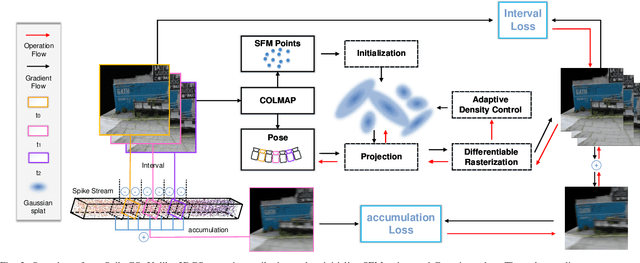

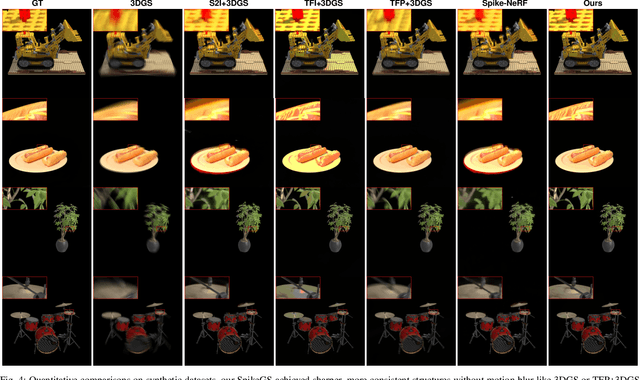
Abstract:3D Gaussian Splatting (3DGS) demonstrates unparalleled superior performance in 3D scene reconstruction. However, 3DGS heavily relies on the sharp images. Fulfilling this requirement can be challenging in real-world scenarios especially when the camera moves fast, which severely limits the application of 3DGS. To address these challenges, we proposed Spike Gausian Splatting (SpikeGS), the first framework that integrates the spike streams into 3DGS pipeline to reconstruct 3D scenes via a fast-moving bio-inspired camera. With accumulation rasterization, interval supervision, and a specially designed pipeline, SpikeGS extracts detailed geometry and texture from high temporal resolution but texture lacking spike stream, reconstructs 3D scenes captured in 1 second. Extensive experiments on multiple synthetic and real-world datasets demonstrate the superiority of SpikeGS compared with existing spike-based and deblur 3D scene reconstruction methods. Codes and data will be released soon.
VOODOO XP: Expressive One-Shot Head Reenactment for VR Telepresence
May 28, 2024Abstract:We introduce VOODOO XP: a 3D-aware one-shot head reenactment method that can generate highly expressive facial expressions from any input driver video and a single 2D portrait. Our solution is real-time, view-consistent, and can be instantly used without calibration or fine-tuning. We demonstrate our solution on a monocular video setting and an end-to-end VR telepresence system for two-way communication. Compared to 2D head reenactment methods, 3D-aware approaches aim to preserve the identity of the subject and ensure view-consistent facial geometry for novel camera poses, which makes them suitable for immersive applications. While various facial disentanglement techniques have been introduced, cutting-edge 3D-aware neural reenactment techniques still lack expressiveness and fail to reproduce complex and fine-scale facial expressions. We present a novel cross-reenactment architecture that directly transfers the driver's facial expressions to transformer blocks of the input source's 3D lifting module. We show that highly effective disentanglement is possible using an innovative multi-stage self-supervision approach, which is based on a coarse-to-fine strategy, combined with an explicit face neutralization and 3D lifted frontalization during its initial training stage. We further integrate our novel head reenactment solution into an accessible high-fidelity VR telepresence system, where any person can instantly build a personalized neural head avatar from any photo and bring it to life using the headset. We demonstrate state-of-the-art performance in terms of expressiveness and likeness preservation on a large set of diverse subjects and capture conditions.
SCSim: A Realistic Spike Cameras Simulator
May 27, 2024
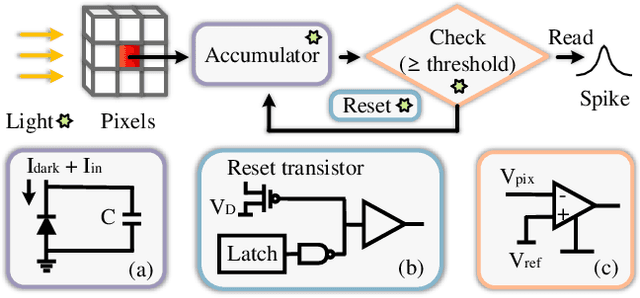
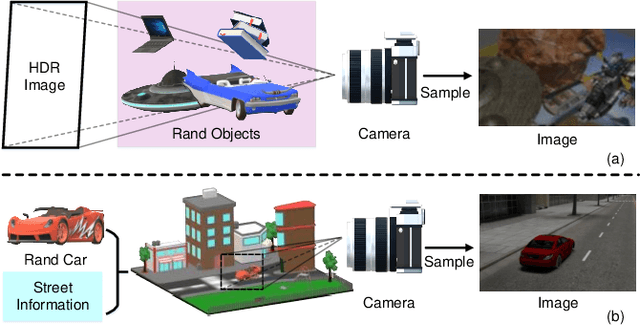

Abstract:Spike cameras, with their exceptional temporal resolution, are revolutionizing high-speed visual applications. Large-scale synthetic datasets have significantly accelerated the development of these cameras, particularly in reconstruction and optical flow. However, current synthetic datasets for spike cameras lack sophistication. Addressing this gap, we introduce SCSim, a novel and more realistic spike camera simulator with a comprehensive noise model. SCSim is adept at autonomously generating driving scenarios and synthesizing corresponding spike streams. To enhance the fidelity of these streams, we've developed a comprehensive noise model tailored to the unique circuitry of spike cameras. Our evaluations demonstrate that SCSim outperforms existing simulation methods in generating authentic spike streams. Crucially, SCSim simplifies the creation of datasets, thereby greatly advancing spike-based visual tasks like reconstruction. Our project refers to https://github.com/Acnext/SCSim.
Spike-NeRF: Neural Radiance Field Based On Spike Camera
Mar 25, 2024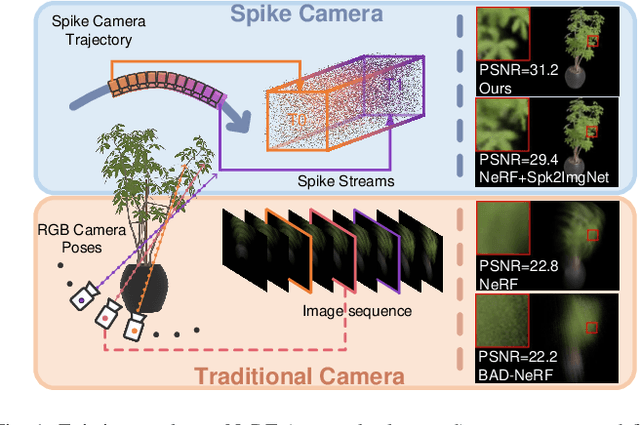
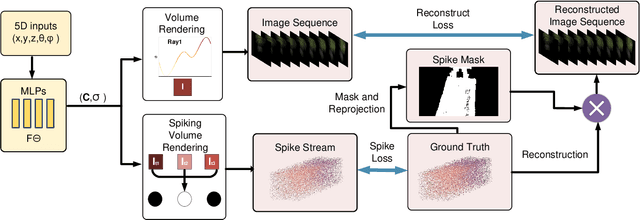
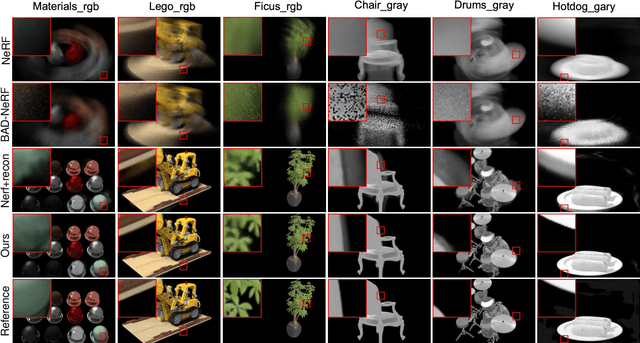
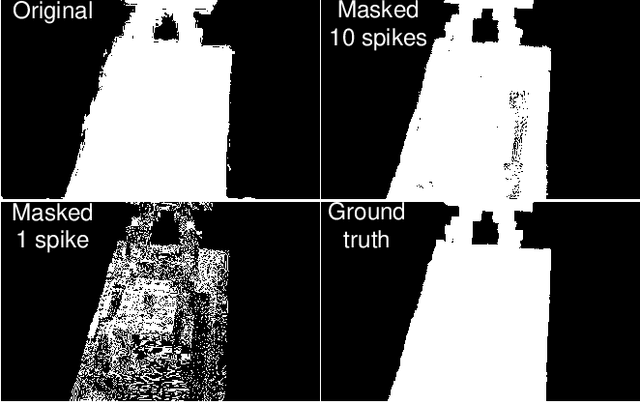
Abstract:As a neuromorphic sensor with high temporal resolution, spike cameras offer notable advantages over traditional cameras in high-speed vision applications such as high-speed optical estimation, depth estimation, and object tracking. Inspired by the success of the spike camera, we proposed Spike-NeRF, the first Neural Radiance Field derived from spike data, to achieve 3D reconstruction and novel viewpoint synthesis of high-speed scenes. Instead of the multi-view images at the same time of NeRF, the inputs of Spike-NeRF are continuous spike streams captured by a moving spike camera in a very short time. To reconstruct a correct and stable 3D scene from high-frequency but unstable spike data, we devised spike masks along with a distinctive loss function. We evaluate our method qualitatively and numerically on several challenging synthetic scenes generated by blender with the spike camera simulator. Our results demonstrate that Spike-NeRF produces more visually appealing results than the existing methods and the baseline we proposed in high-speed scenes. Our code and data will be released soon.
Learning to Robustly Reconstruct Low-light Dynamic Scenes from Spike Streams
Jan 19, 2024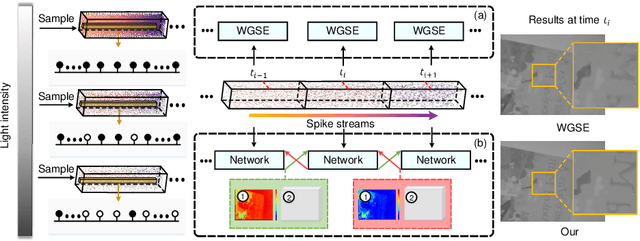


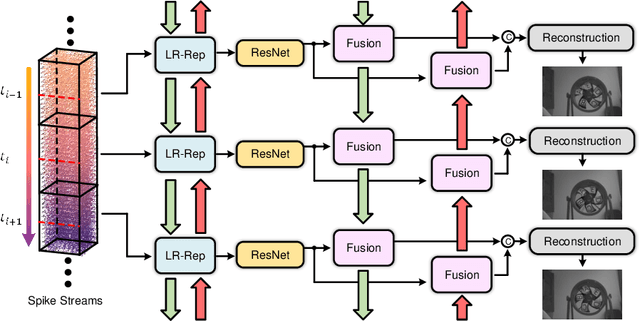
Abstract:As a neuromorphic sensor with high temporal resolution, spike camera can generate continuous binary spike streams to capture per-pixel light intensity. We can use reconstruction methods to restore scene details in high-speed scenarios. However, due to limited information in spike streams, low-light scenes are difficult to effectively reconstruct. In this paper, we propose a bidirectional recurrent-based reconstruction framework, including a Light-Robust Representation (LR-Rep) and a fusion module, to better handle such extreme conditions. LR-Rep is designed to aggregate temporal information in spike streams, and a fusion module is utilized to extract temporal features. Additionally, we have developed a reconstruction benchmark for high-speed low-light scenes. Light sources in the scenes are carefully aligned to real-world conditions. Experimental results demonstrate the superiority of our method, which also generalizes well to real spike streams. Related codes and proposed datasets will be released after publication.
VOODOO 3D: Volumetric Portrait Disentanglement for One-Shot 3D Head Reenactment
Dec 07, 2023

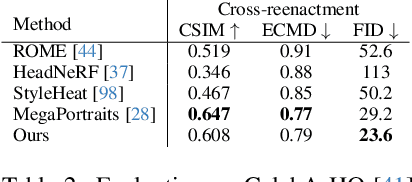
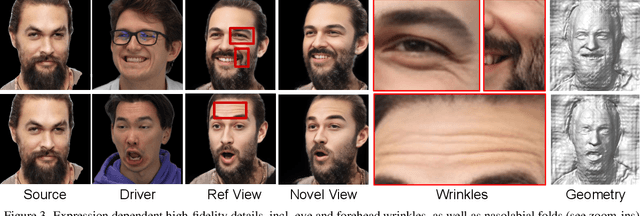
Abstract:We present a 3D-aware one-shot head reenactment method based on a fully volumetric neural disentanglement framework for source appearance and driver expressions. Our method is real-time and produces high-fidelity and view-consistent output, suitable for 3D teleconferencing systems based on holographic displays. Existing cutting-edge 3D-aware reenactment methods often use neural radiance fields or 3D meshes to produce view-consistent appearance encoding, but, at the same time, they rely on linear face models, such as 3DMM, to achieve its disentanglement with facial expressions. As a result, their reenactment results often exhibit identity leakage from the driver or have unnatural expressions. To address these problems, we propose a neural self-supervised disentanglement approach that lifts both the source image and driver video frame into a shared 3D volumetric representation based on tri-planes. This representation can then be freely manipulated with expression tri-planes extracted from the driving images and rendered from an arbitrary view using neural radiance fields. We achieve this disentanglement via self-supervised learning on a large in-the-wild video dataset. We further introduce a highly effective fine-tuning approach to improve the generalizability of the 3D lifting using the same real-world data. We demonstrate state-of-the-art performance on a wide range of datasets, and also showcase high-quality 3D-aware head reenactment on highly challenging and diverse subjects, including non-frontal head poses and complex expressions for both source and driver.
Learning to Listen: Modeling Non-Deterministic Dyadic Facial Motion
Apr 18, 2022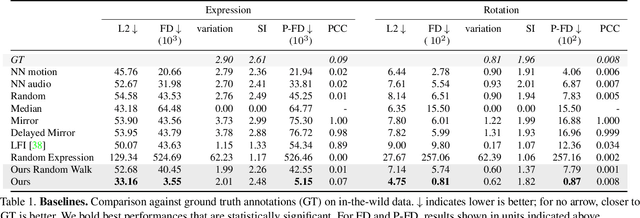



Abstract:We present a framework for modeling interactional communication in dyadic conversations: given multimodal inputs of a speaker, we autoregressively output multiple possibilities of corresponding listener motion. We combine the motion and speech audio of the speaker using a motion-audio cross attention transformer. Furthermore, we enable non-deterministic prediction by learning a discrete latent representation of realistic listener motion with a novel motion-encoding VQ-VAE. Our method organically captures the multimodal and non-deterministic nature of nonverbal dyadic interactions. Moreover, it produces realistic 3D listener facial motion synchronous with the speaker (see video). We demonstrate that our method outperforms baselines qualitatively and quantitatively via a rich suite of experiments. To facilitate this line of research, we introduce a novel and large in-the-wild dataset of dyadic conversations. Code, data, and videos available at https://evonneng.github.io/learning2listen/.
 Add to Chrome
Add to Chrome Add to Firefox
Add to Firefox Add to Edge
Add to Edge